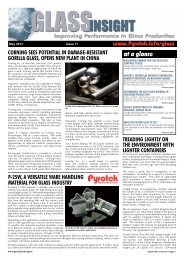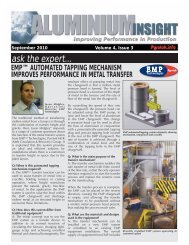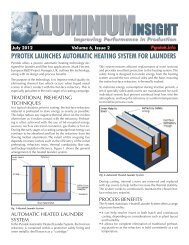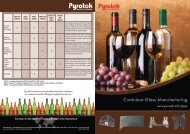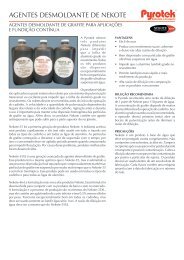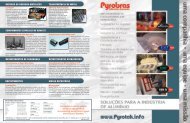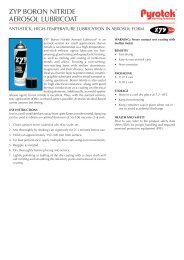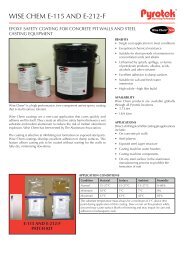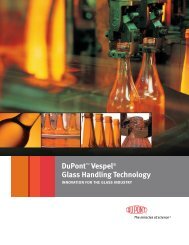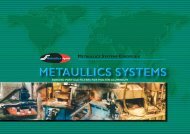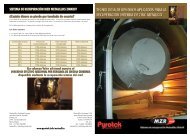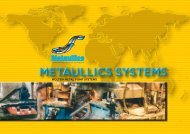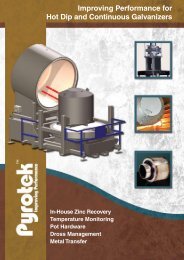Improving Performance - Billet Casting Improving ... - Pyrotek
Improving Performance - Billet Casting Improving ... - Pyrotek
Improving Performance - Billet Casting Improving ... - Pyrotek
Create successful ePaper yourself
Turn your PDF publications into a flip-book with our unique Google optimized e-Paper software.
<strong>Improving</strong> <strong>Performance</strong> - <strong>Billet</strong> <strong>Casting</strong><br />
Figure 22 - Cooling Water<br />
Figure 23 - Mould and Hoses<br />
are >95% biodegradable (Figure 22). This<br />
solution can also save considerable chemical<br />
treatment costs.<br />
COOLing WATER QUALiTY<br />
Cooling water quality plays a critical role<br />
in good billet casting. Some conventional<br />
systems today still use a mould table, which<br />
has external cooling hoses to each of the<br />
moulds (see Figure 23). Most hot top systems<br />
use a Wagstaff-type mould table with integral<br />
water headers that feed cooling water directly<br />
from inside the tabletop to the moulds. A baffle<br />
system, with water screens, is usually used to<br />
prevent large pieces of debris from plugging<br />
the water slots or holes in the mould bore. This<br />
again becomes critical because, if the cooling<br />
water system becomes oil contaminated, then<br />
the water screens quickly become clogged,<br />
with debris from algae and bacteria, thereby<br />
causing hot tears and bleed-outs during the<br />
cast. Many cooling systems are at or near<br />
maximum capacity during casting, and when<br />
more chemicals are added to the cooling water,<br />
the effect of cooling is diminished. As discussed<br />
above, the biodegradable and economical<br />
<strong>Pyrotek</strong> Perlube product range can greatly<br />
reduce oil contamination in the cooling water<br />
and the consequent chemical treatment costs.<br />
BiLLET CASTing COATingS<br />
Coatings also play an important role in<br />
producing good quality billet: in particular<br />
the application of boron nitride and graphite<br />
coatings for T-plates. A good non-wetting<br />
coating will minimize oxide adhesion at cast<br />
start, allowing the billet to get into steady-state<br />
casting mode quickly. This can help to reduce<br />
bottom butt scrap. <strong>Pyrotek</strong> has developed a<br />
premium, proprietary coating for this purpose.<br />
This boron nitride based coating, applied at the<br />
<strong>Pyrotek</strong> factory, withstands 30–40 casts before<br />
recoating of the T-plate becomes necessary.<br />
It also has superior lubricity for good oxide<br />
mobility. T-Kote, an “easy-to-use” companion<br />
coating was developed to enhance protection<br />
of the T-plate. T-Kote comes premixed and<br />
has a slight tint, allowing the operator to<br />
see visually where any spots may have been<br />
missed. Combined, these two products also<br />
offer superior life to the surface of the transition<br />
plate.<br />
Graphite coating is used in<br />
some transition plate and<br />
header coating applications.<br />
It does not offer the lubricity<br />
of boron nitride, but provides<br />
more penetration of the hot<br />
face of the transition plate and<br />
resistance to some metal alloy<br />
constituents less compatible<br />
with boron nitride. <strong>Pyrotek</strong><br />
offers a Naphtha-based graphite coating<br />
called Pyroslip 325/350 (see Figure 24).<br />
Since molten aluminium is very aggressive, a<br />
release agent should be applied to protect the<br />
launder and table surfaces coming into contact<br />
with the metal. Boron nitride coatings and<br />
bone ash are utilised in such applications. In<br />
contrast the binders utilised for the BN coatings<br />
adhere strongly to the various refractory<br />
materials and assist in reducing metal erosion<br />
of the refractory shapes, reducing the damage<br />
associated with maintenance and cleaning<br />
between casts, and with the addition of a blue<br />
colorant, provides an additional assistance<br />
in helping to monitor the effectiveness of<br />
the coating practice. Traditionally, bone ash<br />
was used because of its release properties.<br />
However, due to its poor adhesion, bone<br />
ash must be repeatedly replenished and may<br />
become entrained by the flowing of molten<br />
aluminium. Customers report that in contrast<br />
to bone ash, major reductions in residues and<br />
quicker turn around of casting tables helped<br />
Figure 24 - Pyroslip Products<br />
pyrotek<br />
supplement<br />
John Blasen<br />
global Market<br />
Development Manager,<br />
ZYP - <strong>Pyrotek</strong> Coatings<br />
PYROTEK’S<br />
MiSSiOn<br />
“Providing<br />
innovative<br />
solutions<br />
to customer<br />
needs<br />
utilizing<br />
our global<br />
resources.”<br />
Page 9



